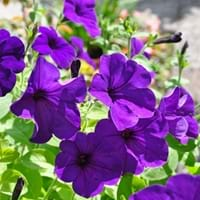Life Span
Perennial
Annual
Type
Vegetable
Flowering Plants, Shrubs
Origin
Hybrid origin, Mexico, Central America, South America
Hybrid origin
Number of Varieties
Not Available
Habitat
Coastal Regions
Terrestrial
USDA Hardiness Zone
11-15
9-10
AHS Heat Zone
12-1
12 - 3
Sunset Zone
A1, A2, A3, H1, H2, 1a, 1b, 2a, 2b, 3a, 3b, 4, 5, 6, 7, 8, 9, 10, 11, 12, 13, 14, 15, 16, 17, 18, 19, 20, 21, 22, 23, 24
A1, A2, A3, H1, H2, 1a, 1b, 2a, 2b, 3a, 3b, 4, 5, 6, 7, 8, 9, 10, 11, 12, 13, 14, 15, 16, 17, 18, 19, 20, 21, 22, 23, 24
Habit
Upright/Erect
Prostrate/Trailing
Flower Color
Yellow
White, Blue, Purple, Pink, Light Pink, Hot Pink, Magenta, Lavender
Flower Color Modifier
Bicolor
Bicolor
Fruit Color
Red
Not Available
Leaf Color in Spring
Green, Dark Green
Green
Leaf Color in Summer
Green, Dark Green
Green
Leaf Color in Fall
Green, Dark Green
Green
Leaf Color in Winter
Green, Dark Green
Light Green
Plant Season
Spring, Summer, Fall
Spring, Summer, Fall
Sunlight
Full Sun
Full Sun
Growth Rate
Fast
Very Fast
Type of Soil
Loam, Sand
Loam, Sand
The pH of Soil
Neutral
Acidic, Neutral
Soil Drainage
Well drained
Well drained
Bloom Time
Indeterminate
Indeterminate
Tolerances
Drought
Drought
Where to Plant?
Container, Ground
Container, Ground, Pot
How to Plant?
Grafting, Seedlings
Seedlings, Transplanting
Plant Maintenance
Medium
Medium
Watering Requirements
Needs more water during establishment
Keep the ground moist but not water-logged, Requires regular watering, Requires watering in the growing season
In Summer
Lots of watering
Lots of watering
In Spring
Moderate
Moderate
In Winter
Average Water
Average Water
Soil Type
Loam, Sand
Loamy, Sandy
Soil Drainage Capacity
Well drained
Well drained
Sun Exposure
Full Sun
Full Sun, Partial shade
Pruning
Pinch or prune as they grow to promote branching and bushiness
Cut or pinch the stems, Do not prune during shooting season, Remove dead or diseased plant parts, Remove deadheads
Fertilizers
14-14-14 Fertilizer, Compost
All-Purpose Liquid Fertilizer
Pests and Diseases
Anthracnose, Aphids, Red blotch, Rust
Red blotch
Plant Tolerance
Heat Tolerance, Salt and Soil Compaction
Drought
Flower Petal Number
Single
Single
Fragrant Bark/Stem
Yes
No
Foliage Texture
Medium
Medium
Foliage Sheen
Matte
Matte
Attracts
Aphids, Not Available, Squirrels
Hummingbirds, Butterflies
Allergy
Stomach pain, Vomiting
Not Available
Aesthetic Uses
Used in parkland
Beautification, Bouquets, Showy Purposes
Beauty Benefits
Anti-ageing, Blackheads, Reduce Bruises
Not Available
Environmental Uses
Shadow Tree, Soil protection
Air purification
Medicinal Uses
Dehydration, Diabetes, Diarrhea, Nutrients, Weight loss
Not Available
Part of Plant Used
Fruits
Flowers
Other Uses
Application in Handicrafts, Food for animals, Showy Purposes
Showy Purposes
Used As Indoor Plant
No
Yes
Used As Outdoor Plant
Yes
Yes
Garden Design
Edible, Herb, Vegetable
Hanging Basket
Botanical Name
Manilkara zapota
PETUNIA 'PAS3187'
Common Name
sapodilla , chikoo, Sapota
Purple Wave Petunia, Spreading Petunia, Wave Purple Petunia
In Hindi
चीकू
Purple wave petunia
In German
Breiapfelbaum
Lila Welle Petunie
In French
Sapotillier
Pétunia pourpre Vague
In Spanish
chicle
Petunia púrpura Wave
In Greek
sapodilla
Purple Wave πετούνια
In Portuguese
sapodilla
Onda roxa do petúnia
In Polish
Pigwica właściwa, sapodilla
Purpurowy fali petunii
In Latin
sapodilla
Purpura unda Petunia
Phylum
Magnoliophyta
Magnoliophyta
Class
Magnoliopsida
Magnoliopsida
Family
Sapotaceae
Solanaceae
Clade
Angiosperms, Asterids, Eudicots
Angiosperms, Asterids, Eudicots
Tribe
Sapoteae
Not Available
Subfamily
Sapotoideae
Petunioideae
Importance of Sapodilla and Purple Wave Petunia
Want to have the most appropriate plant for your garden? You might want to know the importance of Sapodilla and Purple Wave Petunia. Basically, these two plants vary in many aspects. Compare Sapodilla and Purple Wave Petunia as they differ in many characteristics such as their life, care, benefits, facts, etc. Every gardener must at least have the slightest clue about the plants he wants to plant in his garden. Compare their benefits, which differ in many ways like facts and uses. The medicinal use of Sapodilla is Dehydration, Diabetes, Diarrhea, Nutrients and Weight loss whereas of Purple Wave Petunia is Not Available. Sapodilla has beauty benefits as follows: Anti-ageing, Blackheads and Reduce Bruises while Purple Wave Petunia has beauty benefits as follows: Anti-ageing, Blackheads and Reduce Bruises.
Compare Facts of Sapodilla vs Purple Wave Petunia
How to choose the best garden plant for your garden depending upon its facts? Here garden plant comparison will help you to solve this query. Compare the facts of Sapodilla vs Purple Wave Petunia and know which one to choose. As garden plants have benefits and other uses, allergy is also a major drawback of plants for some people. Allergic reactions of Sapodilla are Stomach pain and Vomiting whereas of Purple Wave Petunia have Not Available respectively. Having a fruit bearing plant in your garden can be a plus point of your garden. Sapodilla has showy fruits and Purple Wave Petunia has no showy fruits. Also Sapodilla is not flowering and Purple Wave Petunia is not flowering . You can compare Sapodilla and Purple Wave Petunia facts and facts of other plants too.





